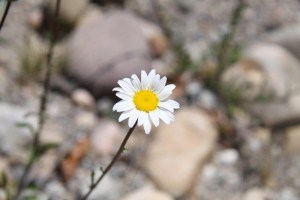
Parks Canada protects and presents Canada’s natural and cultural heritage and fosters public understanding, appreciation and enjoyment in ways that ensure their ecological and commemorative integrity for present and future generations.
One of the challenges to ecological integrity comes from an unlikely source: invasive non-native flowers and plants that we may admire in our gardens but can have a negative impact on the biodiversity of the park. Invasive plants have no natural predators to stop their spread, which means they can grow and thrive in the wilderness with a detrimental impact on native plants. They can also cause damage to natural areas, watersheds and lakes.
Approximately 10 per cent of introduced ornamental plants are invasive, however one that has been particularly problematic for the Jasper National Park restoration crew this year is the Oxeye Daisy.
The Oxeye Daisy is a beautiful flower; however, this abundant perennial is not native to Jasper National Park and can produce over 500 seeds per plant. Â Seeds are spread by the wind and plants expand through rhizomes (i.e. lateral roots). Â When oxeye is allowed to spread, it can easily takeover native vegetation, decreasing not only the plant diversity, but also the forage availability for grazing animals.
This year, the Jasper National Park vegetation crew is focusing its efforts on controlling Oxeye Daisy in the backcountry, where it is critically important to maintain the native vegetation. Stopping the spread of the flower is simply too big a job for Parks Canada alone and the agency is seeking the help of volunteers to help with the control efforts in the more easily accessible areas of the park.
You can help reduce the population of Oxeye Daisy anywhere you travel in the park by collecting the flower heads of any and all oxeye you see on your excursions.  All you need is a zip lock bag and determination. When you come across Oxeye Daisy, remove the flowers and seal them in your zip lock bag.  It’s important that seeds are captured as they can be viable in soil for over three years. The remaining part of the plant can be pulled to remove the root mass from the soil.  Shake the dirt free and leave it exposed to ensure the plant dies.  Dispose of the seed heads you collect in your household waste (regular bagged garbage) or burn them in a designated campfire site.  You may also drop them off at the Jasper National Park compound for disposal. It would also be helpful if you have the ability to record the GPS co-ordinates of where the daisies were picked and pass that information to Parks Canada along with the seeds.
However, please keep in mind that Parks Canada discourages picking other weeds or flowers in the park in order to protect native plants that might be misidentified as weeds. The easily recognizable and frighteningly successful Oxeye Daisy is our one exception to this rule.
For more information and a list of native species that can flourish in your garden and substitute for the Oxeye Daisy visit the Alberta Invasive Species Council at www.abinvasives.ca.
Parks Canada
Special to the 51°µÍø
